Was there “intensive growth” in Classical Greece and was there something special about its causes ? Was it due to “inclusive institutions” ? This post examines some claims of the “New Ancient History”.
(1)
Several months ago The Nation magazine published an article by Timothy Shenk called “The Apostles of Growth” which criticised the fixation of the “new historians of capitalism” on economic growth as the decisive difference between capitalism and what ever the hell they think came before. Ironically, that focus on mere growth is no longer really considered by economic historians a key signifier of the Industrial Revolution, precisely because it has been recognised for some time Europe had seen low but compounding rates of growth earlier. Here for example is a view of long-term British growth that’s disputed but increasingly favoured.
In his much-cited essay, “Efflorescences and Economic Growth in World History: Rethinking the ‘Rise of the West’ and the Industrial Revolution“, Jack Goldstone went so far as to say there had been many prolonged episodes of growth in per capita income throughout human history prior to the British Industrial Revolution. The growth rates were low and ultimately unsustained, but they belied the Eurocentric and modernist tendency to view all of preindustrial history as one long Malthusian stagnation. Much the same territory had been trodden by Eric L. Jones in the book Growth Recurring: Economic Change in World History. Both Goldstone and Jones surveyed the history of mankind and seemed to find many golden ages of “intensive growth”, although they could not cite data for these.
So I’m happy to report that the “New Ancient History” (NAH) has been working hard to quantify many claims about the golden ages of classical antiquity. In fact, if one were to judge by The Cambridge Economic History of the Greco-Roman World, the names associated with NAH like Scheidel, Morris, Saller, Manning, etc. are obviously influenced by neoclassical economics. These figures are apparently reacting against the orthodoxy originating with Moses Finley, who held that ancient economies were not organised along market principles and therefore modern economic analysis was inappropriate. But Finley’s influence was broken by a younger generation of classical historians influenced by the new institutional economics.
So now Peter Turchin and Daniel Hoyer report that the Stanford classicist Josiah Ober is coming out with a new book called The Rise and Fall of Classical Greece — about the supposed half-millennium of “intensive growth” in ancient Greece and its causes. The first chapter of Ober’s book is available online, and, according to the excerpts already visible on Amazon.com, chapter 4 appears to be basically the same as his 2010 article “Wealthy Hellas“. Ober appears very much a part of the “New Ancient History” wave sweeping the classics.
(2)
“Wealthy Hellas” argues that Greek living standards grew in the period 800-300 BCE, along with the size and number of cities, even as the total population of Greece was multiplied many times. Ober attributes this growth to “inclusive institutions” (though he does not use that exact phrase). Here is Ober’s summary of the evidence for inferring economic growth in Greece:
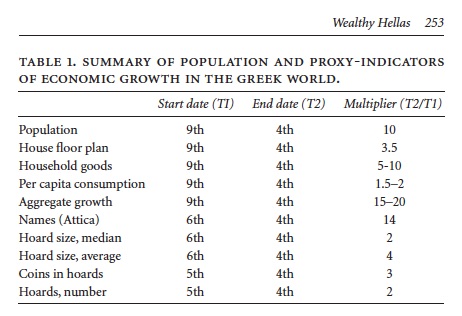
Only housing size and consumption can truly address living standards, with the rest really just indicators of aggregate economic activity. For the evidence on living standards Ober leans heavily on the work of Ian Morris, best known to the world at large as the author of Why the West Rules–For Now.
In “Economic Growth in Ancient Greece“, Morris sifts through various kinds of archaeological evidence and seems to establish two things: in the period 800-300BC, the age at death rose and the size of housing went up.
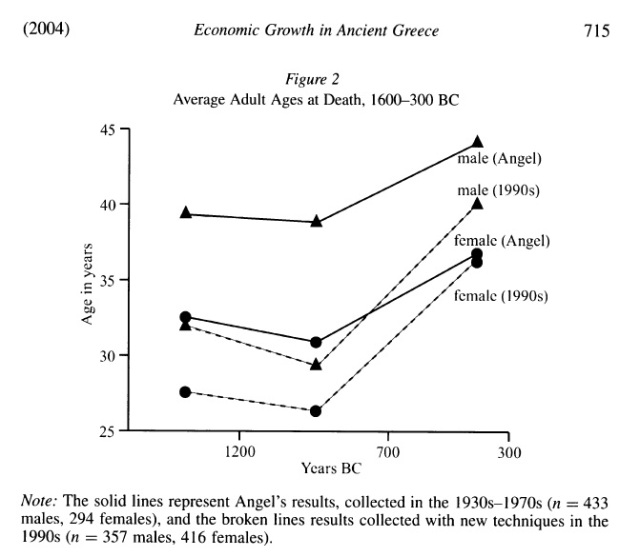 |
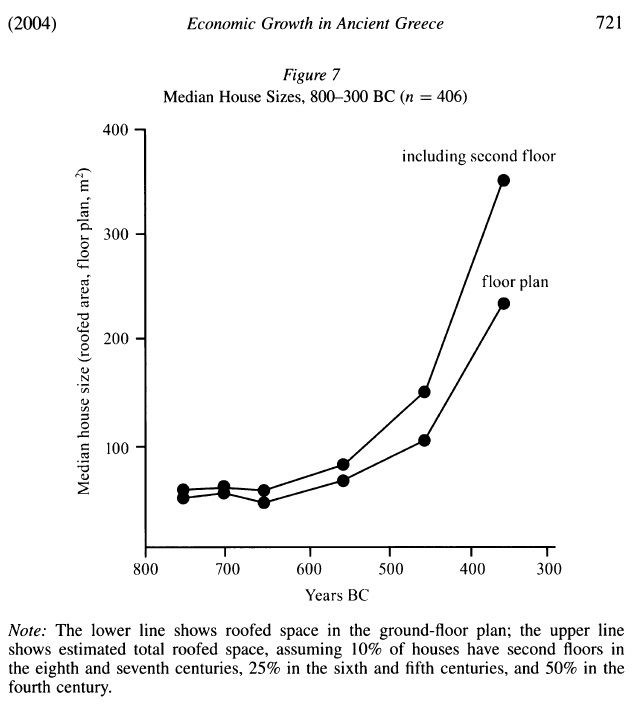 |
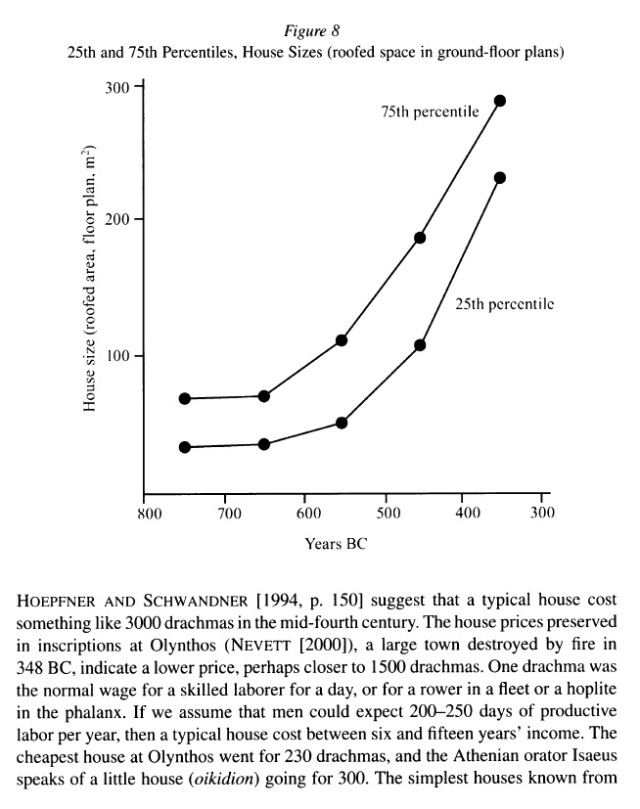 |
On stature he concludes the skeletal samples are just not numerous enough to make any strong conclusions.
Morris concludes the “improvement in living standards… comes to 0.07-0.14 percent per annum” during the half millennium, or cumulatively 50-100%. And this claim is cited by Ober as part of his overall evidence. But this “estimate” strongly resembles a hot dog — it’s better not to know what went into making it.
[*For the meat slime, see Morris 2004, pp 724-6. Also see the first post in the comments section.]
(3)
Another key piece of reasoning that Ober relies on is the population calculations of Mogens Herman Hansen. Using methods summarised here, Hansen estimates the population of mainland Greece in the 4th century BCE, which was approximately coterminous with the Greece of the late 19th century CE. From this he concludes something quite extraordinary :
I don’t know how you can assume land use was the same without knowing something about the distribution of land, the ratio of fallow, and the shares of pastoral and arable. But most importantly from an economic point of view, relative prices must have been outlandishly different in the two periods and would have affected what was planted and how much. Wine and olive oil surely bought much more wheat in the late 19th century CE than in the 4th century BCE, because cheap, mechanically threshed wheat from North America and Ukraine was made available to world markets.
Besides, even if it were admitted that land uses were the same in the two periods, the purely ecological reasoning in the passage above from Hansen is backward. IF the same amount of land in 300 BCE could support up to 1.3 million more people than in 1890 CE, that would imply, all things equal, much higher productivity (of land or labour or both) 2400 years ago than in the late 19th century.
Is that plausible ? It would require there had been considerable growth in agricultural productivity in ancient Greece, so that urban labour could engage in other kinds of production and exchange the output for food. On technological change in agriculture in the millennium preceding the 4th century BCE, Ian Morris himself states quite succinctly there was little :
On the other hand, in The Measure of Civilisation, Morris observes :
Chalk it all up to intensified manuring ?
According to Morris in the paper “The Collapse and Regeneration of Complex Society in Greece 1500-500 BC“, Greek population density tripled or quadrupled or even quintupled between 800 BC and 500 BC. In other words, although the land was supporting many many many more people, the ancient Greek economy was not hitting a Malthusian resource constraint. Land per capita was falling, but income per capita was not. To the contrary, living standards were rising according to Morris. But he apparently does not realise that in order to keep income per capita just constant, even before factoring in the improvement in living standards, there must have been a substantial advance in productivity, whether in yield per hectare of land or in labour productivity.
The higher population density, combined with Morris’s consumption estimates, imply between 450% and 1000% increase in the output per capita of the ancient Greek economy — or 0.3-0.46% per annum over 500 years. That would be faster growth than England in the first half of the 18th century ! Is that believable ? [Edit: I have an addenda post which elaborates on this point.]
Alternatively, even in the absence of major productivity advance in agriculture, it’s possible that the international terms of trade dramatically altered land use in ancient Greece. The olive oils, the wines, and the pottery of the ancient Greeks might have been so highly valued by the non-Greek world that it made sense for Greek farmers en masse to produce less barley and wheat and give more of the land over to olive trees and grape vines. Ober himself recognises that the “imported food had to be paid for somehow”.
But what would have caused this huge demand for Greek goods in the first place ? And is it plausible on the scale implied by the population estimates ? Is there evidence for large-scale conversion of land from subsistence crops to cash crops ? I know Greece imported wheat from the Black Sea region and North Africa, but do the material records attest to the scale of the trade required to produce such surplus populations in Greece ? That’s not addressed in Ober’s article or in Morris.
My larger point is this. Ober, Hansen, and Morris want to use the new population estimates to deduce the economic structure of ancient Greece. But the rather large structural transformation implied by those estimates raise more questions than decide them.
(4)
Or maybe just maybe the population estimates are too high. There might have been growth in consumption per capita as Morris claims, but with more modest population growth.
Then another dimension comes into play: land. Both Ober and Morris have argued that classical Greece broke through Malthusian constraints, i.e., the idea that population and living standards moved inversely in a world of technological stasis. But that simplified Malthusian rule of thumb is only valid under the assumption that the quantity of land is fixed. If land is expanding, it’s possible to have increasing population AND increasing living standards per person, without really anything fundamental changing about the nature of the economic regime.
In presentations of the neo-Malthusian model, the quantity of land is usually held constant. That’s to illustrate that in a world of technological stagnation, there are diminishing returns to labour as population increases on a fixed amount of land, and therefore living standards must fall. But the quantity of land in the model can be varied, i.e., the resource constraint can be relaxed. That may not be obvious from purely verbal or graphical illustrations such as you find in Clark’s A Farewell to Alms, which are intended for undergraduate instruction or popular edification. But in any formal model it is quite obvious.
For example, chapter 3 of Galor contains the bare-bones model of the Malthusian economy, which can easily be calibrated, so that both population and income per worker keep rising, as long as you keep adding extra units of land. (There is a parameter for the response of population to income, and population growth can be less than the growth in land inputs.) I think that’s even implied by Malthus’s own discussion of the New World. It’s fertility behaviour in response to income changes that’s really key in this model.
The model also implies that a one-time spurt or limited growth in the level of technology –such as the introduction of iron implements; or perhaps just intensified manuring and crop rotation in response to population growth (à la Boserup) — can raise per capita income in the short run, even if the long-run outcome is only reverting to the original income.
With a combination of territorial expansion and limited technological change, this “short run” could easily be a matter of several centuries.
(5)
In what is (as far as I know), the first ever statistical test of the mediaeval “heavy plough hypothesis”, Anderson et al. find that the introduction of the heavy plough in the 11th century is associated with approximately 40% of the new towns founded in Denmark in the High Middle Ages. The previous technology — the ard or the scratch-plough — was well-suited to the Mediterranean, but was defeated by the hard clay soils of northern Europe. The purpose of the paper is not about the land input in production, but the implication is pretty clear: the heavy plough opened previously unuseable land to exploitation.
I cite this only because Goldstone mentions the “mediaeval economic revolution” in the effluorescence essay as another probable example of “intensive growth”. Yet it’s a pretty straightforward case of land expansion.
So maybe the golden age of classical Greece was also land-driven ? If, as we have thought for more than a century now, the Greek world had been depopulated during the Dark Ages following the collapse of Mycenaean civilisation, then it’s possible the economic expansion of the 9th-4th centuries BCE was mostly a re-colonisation or re-population process. The new, archaic-era Greek settlements in Macedonia, Thrace, Asia Minor, the Black Sea region, southern Italy, and southern Gaul would represent the emigration of surplus populations in “core” Greece. Then the “effluorescence” would have petered out because this process had hit a political or geographical limit.
One need only compare the territorial extent of the Mycenaean world at the end of 1100 BCE with the revived Greek world circa 550 BCE :
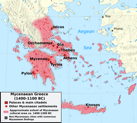 |
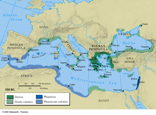 |
The Greek economic efflorescence, then, would seem decidedly non-magical — a product of land and dung.
(6)
But does all this matter ? Yes. Ober speculates about the institutional causes of ancient Greek economic expansion, with much sterile theorising about egalitarian institutions, human capital, transaction costs, risk management, incentives for cooperation, etc. The second half of the “Wealthy Hellas” article reads far more as though a caricature of theory has been substituted for scanty evidence, than theory is guiding the search for evidence.
Maybe land-and-dung expansion does not really require a fancy institutional explanation. Territory expanded, land yields rose, and people have always traded their surpluses. Why invoke “inclusive institutions”, as Ober effectively does, for something so mundane ? Perhaps the seminal cultural accomplishments of classical Greece bias some of us to look for “special” causes of the expansion.
Note, this is not an argument that political economy or “institutions” play no role in the rise and decline of economies. But in this particular case, so little seems established about the descriptive statistics, let alone the “growth accounting”, of Greek economic expansion in 800-300 BCE that it’s premature to be speculating about its institutional causes.
Postscript: The causes of Greek economic growth may have been “ordinary”, but certainly their effects somehow were not. Ober is quite right that the peculiarly egalitarian institutions of the ancient Greeks cry out for an explanation.
Here’s a possible scenario. The collapse of Mycenaean civilisation in the 12th century BCE allowed a “reset” on Greek political evolution, a kind of institutional creative destruction. In the absence of the Late Bronze Age collapse, some Pelopponesian city-state like Mycenae itself or a mainland state like Thebes might have consolidated a circum-Aegean state 800-900 years earlier than Athens would attempt or Macedon would ultimately accomplish. This “reset” prevented the creation of a centralised state in the Aegean for almost a millennium. The population recovery from the Dark Ages was accompanied by land tenure based on small holdings, as we would normally expect in the course of proto-political development with village cultures. This led to the relatively egalitarian city-states of citizen-farmers when Greek poleis started emerging from obscurity again in the 9th century. Hence, Ober’s “rule egalitarnianism”. An effect, not a cause, of economic growth.
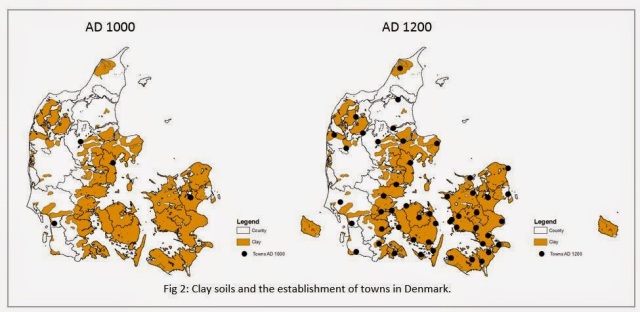
[ * How Ian Morris came up with 0.07-0.14% per annum growth in consumption per capita. The calculations, if you can call them that, do not involve any real data, as far as I can tell. Or they are not shown. Basically Morris starts from the premise that food production / consumption took up most of income in 800 BCE, and subsistence food consumption is defined as 1700 kilocalories. For the 300 BCE benchmark, he assumes, reasonably, that most of the increase in income went to non-food items. The difference between the two benchmarks is partly “factored in” with the “empirical data for changes in nutrition and housing”. Then an “overall sense of the Greeks’ total spending [on public goods, i.e., wars, temples, etc.]” is obtained by “dividing it by changes in population size”. I repeat: no actual data are cited, only differences in hypothetical proportions of the consumption bundles in the two benchmark years.]
LikeLike
I removed this bit from the post because it did not really fit:
Greek economic expansion might still have been “special” if it was precipitated by a very precocious demographic transition in which the link between fertility and income was broken or loosened. A leading theory for why England’s wages remained high long after the Black Death holds that the increase in pastoral land favoured female labour, which caused the age of marriage to rise and thus fertility to fall. (Unfortunately, this is now contradicted by recent data on female wages.)
Morris says the archaeological record of farmsteads show signs of intensified cultivation. Maybe this did not result in greater fertility and/or agricultural involution. In the classic accounts of Chinese agriculture (which are now disputed), more intensely cultivated land eventually led to more population, more subdivision of plots, more labour expended to produce the same or falling output per hectare, etc. Maybe this did not happen in pre-classical Greece. Was there some cultural evolution leading to a proto-modern fertility regime ? Was there an innovation in inheritance customs in the archaic period that minimised the subdivision of plots ?
LikeLike
Pingback: Addenda: the ancient Greek economy & Ian Morris’s calculations | Pseudoerasmus
I’m going to pretend that you posed this as an exam question (without having assigned us the books I obviously haven’t read).
So, at a very high level:
Taking your two maps, it seems likely that Greece did “rebound” from some Mycenaean catastrophe and that 1) the population re-growth aspect of this rebound led to (or was sustained by) massive colonization, and 2) this colonization, though probably brutal enough, did not quite amount to a Greek empire. Greece rebounded BEFORE it consolidated politically, giving us the entrancing but transient classical period. Empire, however, was Greece’s destiny – not in any specifically Greek sense but because that is the kind of world it was. The Greek cities might have become Persian provinces (as some locations did), they might have fallen under “permanent” Athenian sway. The eventual answers (“Alexander”, “Rome”) might have had different names but likely would have been empires. I grant that I don’t answer the question that economic historians want answered – the “how” of the rebound in population and growth in living standards, but I think you have established that we lack the data to answer this question. Instead, I suggest an exogenous partial political cause: the Greeks succeeded because for a long-enough time the was no external power strong enough to prevent their reaching and exceeding their previous accomplishments. I indeed find it remarkable that a country that has been poor for so long in modern times should have been so rich then – I would like to understand this better, but that the archaic and classical Greeks possessed some growth engine that the rest of the world did not share seems very unlikely.
I probably didn’t pass – but it was fun. Great post.
LikeLike
Pingback: Reconstructing history – a population explosion in ancient Greece? « Quotulatiousness
you can now actually read Josiah Ober’s book “The Rise and Fall of Classical Greece” to see what he says about land, population, growth, colonialism, etc. This review by Daniel P. Tompkins in The Washington Monthly helps explain how Athens avoided the Malthusian trap: http://www.washingtonmonthly.com/ten-miles-square/2015/05/the_rise_and_fall_of055826.php#
LikeLike
Yes I know the book is out. I will get to it eventually.
That article does not say anything which cannot be gleaned from the previous Ober article.
By the way, there is no evidence that ancient Greece avoided the Malthusian economic regime. In order to “avoid the Malthusian trap”, you need persistent technological growth and a fertility regime with only a weak connection with income.
LikeLike
Pingback: Ancient History Ancient Greece Reference List | wordpress472
Pingback: History Ancient Greece Annotated Bibliography | wordpress472
From the better late than never file…..
The rapid rise and fall of Mycenaean Greece would make an interesting case study on the effect of institutions on states if we only knew more.
You can’t really talk about that period (ca.1,500BCE – ca.1,200BCE) without having some regard to what is going on in the world around Greece. The big player is Egypt, of course, and there are other states in the Levant and Mesopotamia. To the immediate south is the sophisticated non-Greek Minoan culture in Crete. These states are characterised by institutions such as governments, empire, writing, written laws, money, monumental construction like palaces, irrigation schemes and pyramids. To the north and west are village based cultures. Mainland Greece seems like the gateway between the two worlds.
The Mycenaean Greeks adopt many of these trappings of the Middle Eastern states very quickly but not completely. They take a script used by the Minoans to write in Greek but all we know that is written is palace accounts; no law, no Homeric epics, no boasting by powerful kings.
My pet theory about why they suddenly change is based in metallurgy and trade. From ca. 1700BCE the tin used to make bronze in the Middle East came from Cornwall as local sources had dried up. There is good reason to believe that Mycenae, although it looked south over the Argolid Plain, actually controlled the portage over the Corinth Isthmus. I like to think that the modest Greeks of the Middle Bronze Age suddenly found themselves in the middle of a valuable trade and took advantage. If it’s not too flippant, they could have been the nouveaux riches of the Eastern Med.
Mycenaean culture seems to just peter out. Not long before the end some of the palaces (but not Pylos) build big city walls. The palaces are burnt to the ground but there is no reason to think that invaders are responsible and many cultural elements continue unabated into the historical period centuries later.
In particular the job title of basileus which appears to have been a village headman during the time of the palaces continues unabated. We translate at as ‘king’ once Greece enters the historical period. It’s hard not to believe that the basileus was also the chief in the Middle Helladic period and then just carried on after the collapse of the palace culture.
Economically the palace culture must have brought about huge gains if only for a short time. In addition to community drainage schemes in the Boeotian Plain there are some roads built, there is trade around the Med. The population seems to have grown. And then much of that fades away as the palace culture ends.
So another way of looking at the rebound is that the first peak was artificial and unsustainable. Once Greece built all those institutions for itself organically they enjoyed the benefits more or less until the Macedonian and Roman conquests.
LikeLike
Revisiting this topic as I am returning to the ancient economic history theme. I do take issue with one side comment you make:
“I cite this only because Goldstone mentions the “mediaeval economic revolution” in the effluorescence essay as another probable example of “intensive growth”. Yet it’s a pretty straightforward case of land expansion.”
Surely the medieval economic revolution was driven by both a massive expansion of land inputs (heavier ploughs, deforestation in Germany and elsewhere) and innovations that increased the efficiency with which existing inputs were used especially in the city states of Italy c. 1050-1350 (i.e. more sophisticated contracts, partnerships, accounting methods). Broadberry and Fouquet’s (2015) numbers certainly suggest that intensive growth was going on.
LikeLike
I can definitely believe that for northern Italy. Maybe also for the Hansa cities. But for the Danish wastes?
LikeLiked by 1 person
I think a little agricultural experience would have helped to solve the mystery. (1) Agricultural land increased with time. Greece was deforested and cultivated. (2) The land was improved through terracing, leveling, draining, and most importantly, irrigation. (3) Crop composition evolved, from barley and low grade Gramininea to high yield and value crops and agricultural industries like vine making, cheese making (very important in Greece, soldiers were paid in cheese), olive oil mills, better storage and better administration. (4) Regional integration : Athens could survive on imported food from overseas, exporting agro-industrial, military and cultural goods.
LikeLike
The “puzzle” is the semi-made-up GDP data.
I talk about #1, and #2 is what I mean by the Boserup reference. I also talk about land uses and relative prices (#3). and I ask about imported grains (#4). In short, I discuss your solution, albeit very parsimoniously and not with your detail.
It doesn’t solve the ‘puzzle’ because the assertions about the population growth and the living standard improvements are very very strong.
LikeLike
Reblogged this on Calculus of Decay .
LikeLike